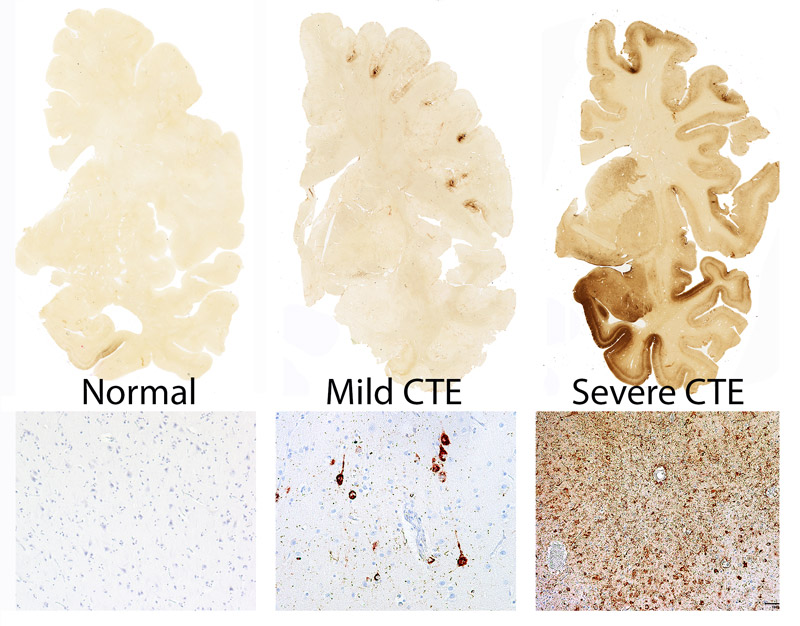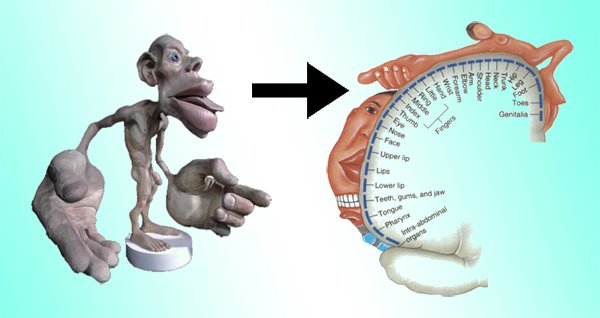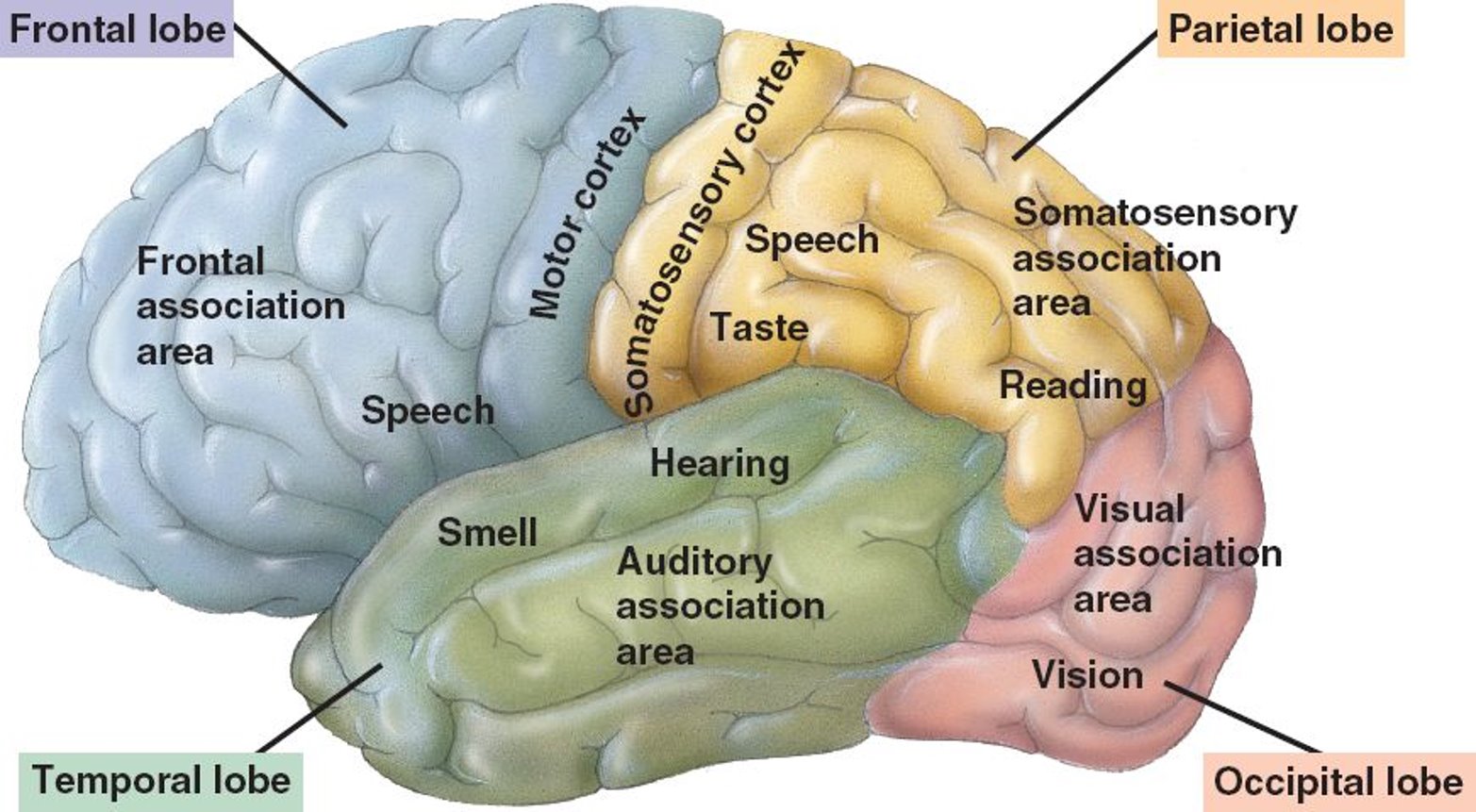AOS 2 Brain
1/53
Earn XP
Description and Tags
Name | Mastery | Learn | Test | Matching | Spaced |
|---|
No study sessions yet.
54 Terms
What are the key areas of the forebrain
The forebrain holds the cerebral cortex, hypothalamus and thalamus
What are the key areas of the midbrain
Reticular formation (sends info to the right part of the brain)
What are the key areas of the hindbrain
Medulla, brain stem and cerebellum
What is the role of the midbrain
Movement, processing of visual, auditory and tactile sensory information, sleep and arousal
What are the lobes of the brain with primary areas
F.P.O.T.
Frontal lobe- primary motor cortex
Parietal lobe- primary somatosensory cortex
Occipital lobe- primary visual cortex
Temporal lobe- primary auditory cortex
What’s the association cortex for the occipital lobe
The visual association area/cortex
What is the role of the primary cortex of the frontal lobe
The primary motor cortex is responsible for initiating voluntary movement
What is the role of the primary cortex of the parietal lobe
The primary somatosensory cortex is responsible for receiving and processing touch, temperature, pressure, somatic
What is the role of the primary cortex of the Temporal lobe
Processes auditory information
Uses hemisphere specialisation for the sounds:
Right: processes nonverbal sounds like bells and sirens
Left: processes sounds associated with language
What is the role of the primary cortex of the Occipital
respond to specific features of visual information. Collateral organisation
What does the association cortex do in the frontal lobe
Planning, problem solving, thinking, Memory, Language, Learning, Analysing, emotional behaviour, Personality/Changing personality.
What does the association cortex do in the parietal lobe
Right Parietal: Perceive 3D shapes and designs & drawing a picture of objects
Spatial awareness and location of objects in the environment
Left Parietal: Helps to integrate reading, writing and mental arithmetic
What does the association cortex do in the Occipital lobe
Recognizing faces (facial recognition)
Identifying objects
Interpreting motion and depth
Linking visual info to memories (e.g., “That’s my dog” instead of just “a brown shape”)
What does the association cortex do in the Temporal lobe
Understands what the sounds mean (like speech, music, or a familiar voice).
What is the role of the medulla
The medulla controls automatic bodily functions like heartbeat, breathing and other vital bodily functions
What is the role of the Cerebellum
The cerebellum otherwise known as the mini brain coordinates movement and balance. Balance and posture, coordination, motor learning, timing and rhythm, fine muscle control etc
What is the role of the Pons
The pons controls movement, breathing, sleeping, dreams and walking
What is the role of the Brainstem
The brainstem regulates reflex and survival responses.
What is the role of the hypothalamus
The hypothalamus regulates emotions and instinctive drives (Hunger, thirst, need to sleep, fight or flight, reproduction)
What is the role of the cerebral cortex
The cerebral cortex is the thin outer layer of the brain often called gray matter. It is responsible for higher mental processes and complex behaviours (the higher level functioning of all lobes)
What is the role of the Corpus callosum
The corpus callosum connects both the left and right hemispheres of the brain and sends the signals between them
What is the cerebrum
The four lobes
What is the role of the Hippocampus
The hippocampus specialises in long-term memory and spatial orientation and memory of those places
What is the role of the Amygdala
Responsible for aggression and fear, emotional memory
What is the role of the Spinal cord
The spinal cord relays information from the brain to the rest of the body, and some simple reflexes
What is the role of the Midbrain
The mid brain coordinates movement, sleep and arousal
What is reticular formation
What is reticular formation
What is plasticity
plasticity otherwise known as neuroplasticity refers to the way the brain changes in response to its environment.
The process of plasticity occurs at the synaptic connections for the brain and is necessary for a person’s learning to take place.
What is Experience-Expectant learning/plasticity
DEVELOPMENTAL/NEW brain change in response to environmental influence that is ordinarily expected.
It occurs during developmental stages
Is described as ‘species wide’ as all species have the same experience
Example: exposure to light and patterns for humans in early life develops the visual cortex
Has a sensitive/critical period
*it is expected to happen!*
What is Experience-Dependent learning/plasticity
ADAPTIVE/CHANGE changes in the brain that modifies neuronal structure that is already present
Depends on exposure to environmental experiences
No sensitive or critical period
Example: London Taxi Drivers, throught their extreme training, have more developed Hippocampus structures (responsive for spatial navigation)
When do you have the most plasticity and why?
You have the most brain plasticity (neuroplasticity) during early childhood, especially from birth to around age 5|This high level of plasticity is due to factors such as rapid brain growth, less specialization, and the high learning demands placed on children as they interact with their environment.
What is Sprouting
GROWING Sprouting is the ability of dendrites or axons to develop new extensions or branches
dendritic branching
Filigree appendages (axon growth)

What is Rerouting
the ability of a neuron that is connected to a damaged neuron to create an alternative synaptic connection with an undamaged neuron

What is pruning
the elimination of synaptic connections (dendrites) that are not adequately activated (The connections are still there but some dendrites drop therefore making the connection weaker and the pathway harder to access)

What are some things that impact plasticity
🔼 Increases Plasticity | 🔽 Decreases Plasticity |
|---|---|
Learning new things | Chronic stress |
Repetition & regular practice | Poor sleep |
Physical exercise (especially cardio) | Lack of physical activity |
Good sleep | Boredom or no mental stimulation |
Healthy diet (omega-3s, vitamins) | Poor diet (junk food, low nutrients) |
Positive social interaction | Isolation or loneliness |
Challenging your brain (puzzles, new skills) | Doing the same easy tasks repeatedly |
Young age | Aging (natural decline over time) |
Think of plasticity like a muscle—you can train it, but you also have to take care of it.
Want me to turn this into a simple table or chart?
What does ABI stand for
Acquired brain injury
What does CTE stand for
Chronic traumatic encephalopathy
What is an ABI
any type of brain damage or disorder after birth that impairs or interferes with normal functioning of the brain, either temporarily or permanently.
May include (but not limited to):
Sporting accidents
Falls
Blows to the head
Brain Inflammation
Epilepsy
Degenerative Brain Disorders: Dementia, Alzheimers Disease, Parkinson’s Disease, Motor Neurone Disease
Brain cancer
Examples: Phineas Gage, Aphasia,
What are some biopsychosocial factors that are effected by an ABI
🧠 Biopsychosocial Factors Affected by ABI
🔴 Biological | 🔵 Psychological | 🟢 Social |
|---|---|---|
🔴 Motor impairments (e.g. weakness, paralysis) | 🔵 Memory loss or difficulty concentrating | 🟢 Strained relationships (family, friends) |
🔴 Fatigue and sleep problems | 🔵 Mood swings or emotional instability | 🟢 Loss of employment or school participation |
🔴 Seizures or headaches | 🔵 Depression and anxiety | 🟢 Social isolation or withdrawal |
🔴 Speech or language difficulties | 🔵 Poor self-awareness or impulse control | 🟢 Reduced independence (relying on caregivers) |
🔴 Sensory changes (hearing, vision, etc.) | 🔵 Personality changes | 🟢 Difficulty communicating in social settings |
🔴 Hormonal changes (due to brain damage) | 🔵 Low motivation or apathy | 🟢 Changes in family dynamics or roles |
What does contemporary research refer to
Contemporary research refers to recent or current scientific studies and findings — usually from the last 10–15 years, but often even more recent.
It focuses on:
Up-to-date methods and technologies
Modern theories and perspectives
Real-world relevance in today’s context
For example, in brain science, contemporary research might study neuroplasticity, brain-computer interfaces, or new rehab methods after ABI.
What is CTE
CTE is a progressive and fatal and degenerative brain disease associated with repeated traumatic brain injuries like concussions and repeated blows to the head. It is also associated with the development of dementia/has very similar symptoms
What are symptoms of CTE
Symptoms vary from person to person person but they can have rehabilitating and life changing effects
Loss of memory
Mood changes
Personality changes
Difficulty in controlling impulsive or erratic behaviour
Increasing confusion or disorientation.
Impaired judgement
Motor impairments
Depression and anxiety
What are some biopsychosocial effects of CTE
🧠 Biopsychosocial Effects of CTE (Chronic Traumatic Encephalopathy)
🔴 Biological | 🔵 Psychological | 🟢 Social |
|---|---|---|
🔴 Brain degeneration | 🔵 Depression | 🟢 Relationship breakdowns |
🔴 Headaches and dizziness | 🔵 Anxiety | 🟢 Loss of employment or sports career |
🔴 Motor problems (tremors, unsteadiness) | 🔵 Aggression or mood swings | 🟢 Social withdrawal or isolation |
🔴 Sleep disturbances | 🔵 Poor impulse control | 🟢 Legal or behavioural issues |
🔴 Memory loss | 🔵 Confusion and poor concentration | 🟢 Reduced independence or need for care |
What is CTE (What’s happening in brain)
CTE happens when after repeated blows to the head a protein called tau builds up in the brain and forms cell clumps. These clumps of tau damage the brain cells, making them work less well and eventually causing them to die. This leads to parts of the brain shrinking over time.
Over time, this leads to:
Brain shrinkage
Loss of neurons
Worsening symptoms (memory loss, mood changes, movement problems)

what is a CTE brain compared to a normal brain
🧠Tau protein – normal vs CTE brain:
Normal Brain | CTE Brain | |
|---|---|---|
Tau protein role | Stabilizes microtubules (helps brain cells transport nutrients and signals) | Becomes abnormal and tangled |
Appearance | Spread evenly and lightly, doing its job | Clumps into twisted tangles (called neurofibrillary tangles) |
Effect on neurons | Keeps neurons healthy and connected | Kills neurons, causing brain tissue to shrink |
Location | Present across the brain where needed | Builds up in specific areas (frontal/temporal lobes, sulci) |
🧬 Simple comparison:
🟢 Normal tau: Like scaffolding—supports healthy brain structure.
🔴 CTE tau: Like snarled wires—damages the brain by choking off cells.

What’s the difference between Case Study and an experiment
A case study is an in-depth look at one person, group, or situation to understand it better. It's more descriptive and focuses on real-life details.
An experiment tests a specific hypothesis by changing one thing and seeing how it affects another. It usually happens in controlled conditions and focuses on cause-and-effect.
What are some ethical concepts and guidelines and what’s the difference between ethical concepts and guidelines
What is an Ethical Concept? | What is an Ethical Guideline? |
|---|---|
Ethical concepts are broad ideas or principles that guide researchers on how to treat participants and conduct studies responsibly. | Ethical guidelines are specific rules or standards that help researchers follow ethical concepts in their research practices. |
Ethical Concept | What It Means | Guideline | What It Means |
|---|---|---|---|
Nonmaleficence | Do no harm. | Confidentiality | Keep participants' information private. |
Integrity | Be honest and truthful. | Voluntary Participation | Participants choose to join without pressure. |
Justice | Fairness in research. | Withdrawal Rights | Participants can leave the study anytime. |
Respect | Treat people with dignity. | Informed Consent | Get participants' permission after explaining the study. |
Beneficence | Maximize benefits, minimize harm. | Deception | If used, deception must be explained later. |
Debriefing | Explain the study's purpose and results after it's done. |
What is the Homunculus for the frontal lobe
The amount of motor cortex devoted to each body part corresponds to the complexity of movement.

What is the Homunculus for the Somatosensory cortex
The amount of sensory cortex devoted to each body part corresponds to the level of sensitivity these bodily areas have.
The greater the number of sensory receptors in body and skin, the more sensitive that area is

What is contralateral organisation
Info is contralaterally organised:
Right visual field processed in left occipital lobe.
Left visual field processed in right occipital lobe.
also
If you move your right hand, the left side of your brain is doing the work.
If you hurt your left foot, the right side of your brain processes that pain.
What is Aphasia
Aphasia is when someone has trouble speaking, understanding, reading, or writing because of brain damage — often from a stroke. It doesn’t affect how smart they are, just how they use language.
What is Wernicke’s Aphasia
Wernicke’s area is in the left temporal lobe.
Wernicke’s aphasia is when a person tries to say certain words, but they come out wrong or as other words. They often can’t understand language, and may also have trouble reading and writing.
Their speech is fluent but often meaningless.
It is an ABI
They are unaware of their disability
What is Broca’s Aphasia
Broca’s area is located in the left frontal lobe, near the part of the primary motor cortex that controls the lips, tongue, and mouth.
Broca’s aphasia happens when this area is damaged.
People with it:
Understand language well
Know what they want to say
But have trouble speaking clearly — they may speak slowly, leave out words, or struggle to find the right ones.
they are aware of their disability

Brain Diagram